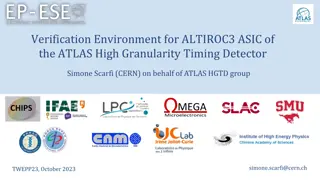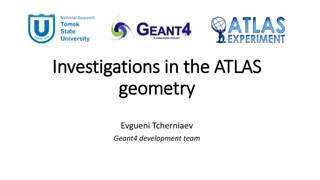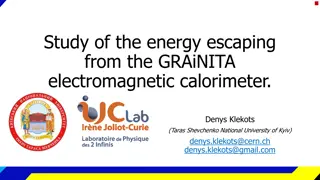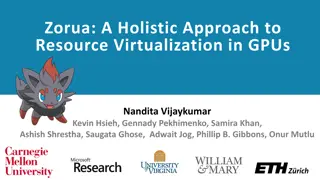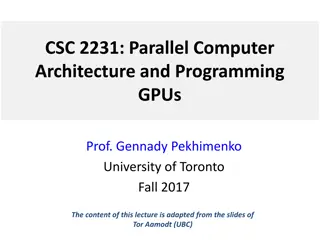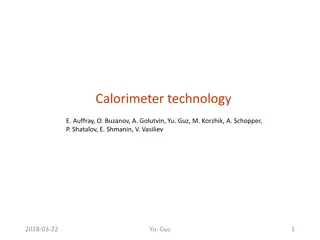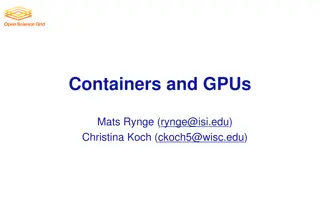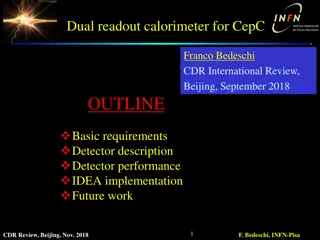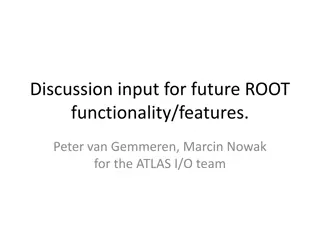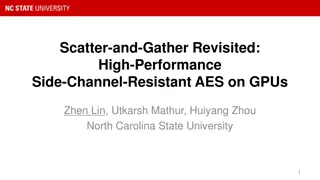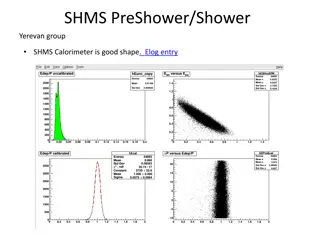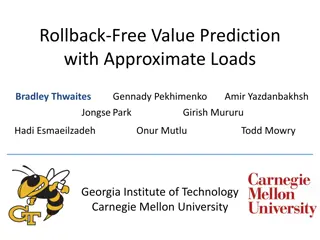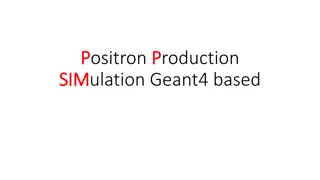FastCaloSim on GPUs - Accelerating Simulation Performance for ATLAS Calorimeter System
FastCaloSim on GPUs project aims to optimize the performance of the ATLAS calorimeter system simulation by porting it to GPUs. The initiative involves exploring parallelization and GPU acceleration to enhance simulation efficiency. With a focus on TFCSLateralShapeParametrizationHitChain
Download Presentation

Please find below an Image/Link to download the presentation.
The content on the website is provided AS IS for your information and personal use only. It may not be sold, licensed, or shared on other websites without obtaining consent from the author.If you encounter any issues during the download, it is possible that the publisher has removed the file from their server.
You are allowed to download the files provided on this website for personal or commercial use, subject to the condition that they are used lawfully. All files are the property of their respective owners.
The content on the website is provided AS IS for your information and personal use only. It may not be sold, licensed, or shared on other websites without obtaining consent from the author.
E N D
Presentation Transcript
FastCaloSim on GPUs BNL CSI: Zhihua Dong, Kwangmin Yu, Meifeng Lin ATLAS: Tadej Novak, Ahmed Hasib, Heather Gray + Others
FastCaloSim Fast simulation of ATLAS calorimeter system Relatively self-contained => initial target for performance analysis and GPU porting exploration Original standalone version runs under the ROOT interpreter Difficult to use standard profiling tools Parallelization/GPU porting would also be difficult Developed a compiled version of standalone FCS program runTFCSShapeValidation Project funded by HEP-CCE Collaboration between ATLAS and BNL Computational Science Initiative
Performance Profile Performance Profile TFCSLateralShapeParametrizationHitChain::simulate() is the most significant routine except I/O parts. TFCSLateralShapeParametrizationHitChain::simulate() The running time scale with the number of events . TFCSLateralShapeParametrizationHitChain::simulate() is our target to parallelize. 1000 event I/O routines
Analysis Analysis TFCSLateralShapeParametrizationHitChain::simulate() Structure TFCSLateralShapeParametrizationHitChain::simulate() { Loop on nhit Loop on hit_simulation_chain Possible Parallelization Impossible Parallelization because of data dependency Call End Loop End Loop }
GPU Porting GPU Porting Dependence on ROOT and C++ nature of FCS would make it difficult to use OpenACC/OpenMP Initial path: using CUDA Port the parallelization possible part in TFCSLateral~~~HitChain::simulate() Implemented CUDA kernel & device functions Data structure relocation from CPU to GPU Geometry data can be loaded once and be reused
FCS GPU acceleration FCS GPU acceleration For validation against GEANT4 ~50000/event Loop on Nhits TFCSCalculateCenterPosition:: simulate_hit Save Extraop center info (simple) Identify hit Cell Fill Various Histograms from Cell geo and Hit coordinates. Save Hit (cell ) TFCSValidationHitSpy:: simulate_hit TFCSHistoLateralShapeParametrization:: simulate_hit Setup Hit (phi, eta, Z, E) CUDA Wiggle hit phi Identify new cell Add cell to a map Accumulate cell s Hit count (or Eerngy) in Simlustate TFCSHitCellMappingWiggle:: simulate_hit GPU version of the 4 functions 1st stage Nhits Threads Fill Various Histograms from Cell geo and Hit coordinates. If new cell match previous cell Fill few more Histograms TFCSValidationHitSpy:: simulate_hit (AGAIN) End Loop
Tasks for Porting to GPU Tasks for Porting to GPU GPU Function to identify cell. getDDE( sample, eta, phi ) Load Geometry Info to GPU. (Deep Copy) ~200,000 Calo Cells in 24 Layers (samples). 20+MB (code setup run on Layer 2 has around 20,000 cells) Various regions Geo info and cell pointers Re-implement GPU CaloGeomory structure and supporting Classes Simpler, no ROOT Dependence, only needed methods GPU Histograms Multi-Stage CUDA kernels Block-wise atomic update with shared memory Reduction of results from all blocks GPU Hit Cell Counting ~50000 hits end up in < ~200 cells (out of ~20,000) Multi Stage CUDA kernels Extra step to narrow down hit cells before standard GPU Histogram(count).
Total 40.4ms Each Event. 3.4ms Prepare Simulation 31.3ms Loop on hits. ~50K ValidationEnergyAndCells PrametrizationChain CenterPositionCalculation ValidationHitSpy HistoLateralShapeParametrization ValidationEnergy LateralShapeParametrization HitChain Parametrization EbinChain PrametrizationChain HitCellMappingWiggle ValidationHitSpy WriteCellsToTree ~4.5K ValidationEnergy CenterPositionCalculation PrametrizationChain LateralShapeParametrization HitChain HistoLateralShapeParametrization HitCellMappingWiggle ParametrizationEbinChain 3.3ms Total ~6.5K LateralShapeParametrization HitChain Engergy Interplotion Spline LateralShapeParametrization HitChain Prametrization PDGIDSelectChain Parametrization AbsEtaSelectChain Parametrization EkinSelectChain Parametriza tion EbinChain LateralShapeParametrization HitChain LateralShapeParametrization HitChain PrametrizationChain ValidationEnergyAndHit LateralShapeParametrization HitChain 2ms
Code Strucuture G++ nvcc (host code) Device Code Load_geometry() ; for (ievent=0; ievent<nevent ievent++) { rand_gen_init(); Init_gpu () ; Prepare_simulation(); for( auto ichain : m_chains) { ichain-> simulate() } Simulate_Hit_gpu(args){ cuMalloc( ); malloc( ) ; __global__ kernel_A(args){ Hit hit; CenterPositionCal(hit&, args); If(spy) HitSpy(args, hit&); HistoLateralHit(args,hit&); CellMapWiggle(args,hit&); If(spy) HitSpy(args, hit& ); } rand_gen(); blocksize=512; nblock=args.nhits/blocksize Kernel_A<<<nblock, blocksize>>>(args); finish_gpu() rand_gen_finish() } blocksize=64 ; nblock=ncells/blocksize ; kernel_B<<<nblock, blocksize>>>(args) ; cudaMemcpy( hitcells, ) ; cudaMemcpy(num_hitcells ) ; Kernel_C<<< .>>>(args); Kernel_D<<< .>>>(args) cudaMemcpy( hitcells_counts, ) ; HitSpy_stage2<<< >>>(args) HitSpy_stage3<<< >>>(args) TFCSLateralParametrizationChain::Simulate(){ If(nhits>2000 && my_chain_type ) { Load_2Dfuction() ; Load_wiggle1Dfunction(); args=prepare(); Simulate_Hit_gpu(args) } else { for(ihit=0;ihit<nhit; nhit++) for(auto ichain : m_chain) ichain->SimulateHit_cpu(); } . } .. cuFree( ) Free( ) }
Tests with multiple instances running Validation against GEANT4 most time consuming (~50K hits) Run sample program on the same node with up to 32 instances Use CUDA-MPS to share 2 P100 GPUs on BNL Institutional Cluster ~5X gain with 50K hits compared to CPU only runs (32 parallel processes). Without hitspy With Hitspy
Progress at Hackathon this week Trying to optimize the code for production-like environments More particles and energies studied Fewer hits needed than Validation against Geant4 Particle Electron Electron Electron Electron Photon Pion Pion Energy Min Eta 65536 65536 65536 65536 65536 65536 32768 CPU (s) / 10K event GPU (s) / 10K event 0 18.3 18.8 19.2 19.8 18.7 7.7 4.5 8.3 8.0 7.9 8.5 6.9 5.7 4.4 0.2 1 Max nhits ~4000-5000 2.2 0.2 0.2 0.2 Max nhits ~2000-2500 Only some events use GPU
TODO Further optimize the CUDA code Use shared memory for the simulation Multiple particles/energies per event => potentially increase GPU utilization Parallelize hits at different layers (right now only one layer at a time) Kernel fusion to reduce overhead Try out portable solutions: Kokkos, RAJA, OpenMP/OpenACC, SyCL
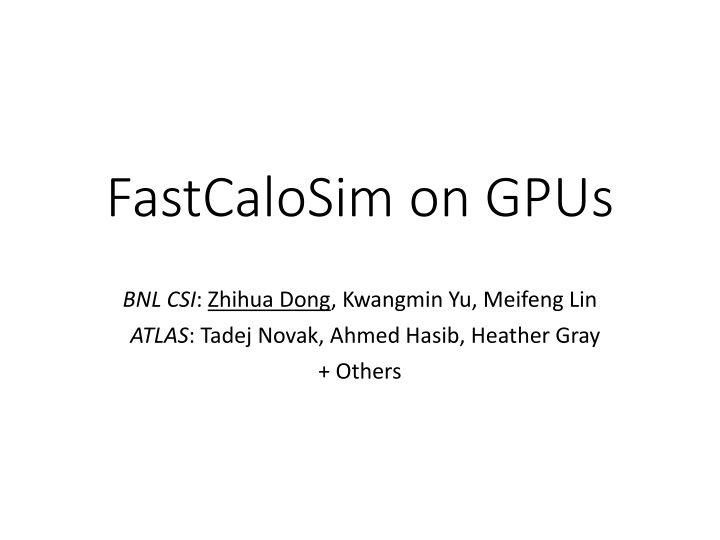

![[PDF⚡READ❤ONLINE] Road Atlas for the Total Solar Eclipse of 2024 - Color Editio](/thumb/21696/pdf-read-online-road-atlas-for-the-total-solar-eclipse-of-2024-color-editio.jpg)

